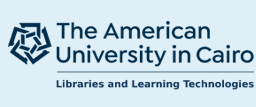-

Reliable wireless sensor networks topology control for critical internet of things applications
Dina Deif and Yasser Gadallah
[abstract not available]
-

A Methodology for Evaluating the Hygroscopic Behavior of Wood in Adaptive Building Skins using Motion Grammar
Rana El-Dabaa and Sherif Abdelmohsen
[abstract not available]
-

Security analysis of chaotic baker maps
Amira Elhamshary, Yehea Ismail, and Said Elkhamy
[abstract not available]
-

Nonlinear robust control of a quadcopter: Implementation and evaluation
Amr M. Elhennawy and Maki K. Habib
[abstract not available]
-

Oral History in Times of Change: Gender, Documentation, and the Making of Archives: Introduction
Hoda Elsadda and Hanan Sabea
Oral history archives have always been at the forefront of liberatory social movements in general, and of feminist movement in particular. Until the end of the twentieth century in the Arab world, archives of women’s oral narratives were almost non-existent with the exception of small documentation efforts tied to individual research. However, since 2011, there has been a marked increase in the documentation of projects. In this context, the Women and Memory Forum organized a conference in 2015 about the challenges of creating gender sensitive oral history archives in times of change. The papers in this collection shed light on documentation initiatives in Arab countries in transitional and conflict situations, in addition to international experiences. They engage with questions around archives and power, the challenges and opportunities presented by new technologies to the making and preserving of archives, ethical concerns in the construction of archives, women’s archives and the production of alternative knowledge, as well as conceptual and methodological issues in oral history.
-

SOAP: SDN overlay across providers for IoT cognition services
Walaa F. Elsadek and Mikhail N. Mikhail
[abstract not available]
-

The effect of entrepreneurial market orientation on firm performance: The case of SMEs in Egypt
Heba M. Elshourbagy and Hesham O. Dinana
[abstract not available]
-

Heterogeneous ITS Architecture for Manned and Unmanned Cars in Suburban Areas
Salma Emara, Ayah Elewa, Omar Wasil, Kholoud Moustafa, and Nada Abdel Khalek
[abstract not available]
-

Effect of using a collaborative video-based self-evaluation activity on helping AFL student-teachers tie theory to practice
Raghda El Essawi
[no abstract provided]
-

Secularism, Sectarianism, and Spirituality in Sinan Antoon’s The Corpse Washer
Ferial J. Ghazoul
The presence of religion in literature is not a new phenomenon. Religion is a part of culture; its popular manifestations and diverse interpretations and beliefs have often been exposed in literary works from Milton to Dostoevsky, from Dante to Flaubert. Images of religion are often interwoven in literary works and different aspects and manifestations of religion may be emphasized -doctrines, ethics or rituals. If we examine the presence of Islam in Arabic literary works, we find different types of Islam presented, and this is not surprising since Islam has many faces in the life of Muslim societies, from its institutional formulation to popular Islam as lived by the people.
-

Recuperating Women’s Memory as Knowledge: Sudan’s Conflict Zones
Sondra Hale
Oral history archives have always been at the forefront of liberatory social movements in general, and of feminist movement in particular. Until the end of the twentieth century in the Arab world, archives of women’s oral narratives were almost non-existent with the exception of small documentation efforts tied to individual research. However, since 2011, there has been a marked increase in the documentation of projects. In this context, the Women and Memory Forum organized a conference in 2015 about the challenges of creating gender sensitive oral history archives in times of change. The papers in this collection shed light on documentation initiatives in Arab countries in transitional and conflict situations, in addition to international experiences. They engage with questions around archives and power, the challenges and opportunities presented by new technologies to the making and preserving of archives, ethical concerns in the construction of archives, women’s archives and the production of alternative knowledge, as well as conceptual and methodological issues in oral history.
-

Testimonio as Methodology: Archiving, Translating, and Theorizing Egyptian Women’s Experiences of Gendered Violence in the January 25th Revolution
Manal Hamzeh
Oral history archives have always been at the forefront of liberatory social movements in general, and of feminist movement in particular. Until the end of the twentieth century in the Arab world, archives of women’s oral narratives were almost non-existent with the exception of small documentation efforts tied to individual research. However, since 2011, there has been a marked increase in the documentation of projects. In this context, the Women and Memory Forum organized a conference in 2015 about the challenges of creating gender sensitive oral history archives in times of change. The papers in this collection shed light on documentation initiatives in Arab countries in transitional and conflict situations, in addition to international experiences. They engage with questions around archives and power, the challenges and opportunities presented by new technologies to the making and preserving of archives, ethical concerns in the construction of archives, women’s archives and the production of alternative knowledge, as well as conceptual and methodological issues in oral history.
-

Narrating Gender in Egypt’s Public Sphere: The Archive of Women’s Oral History
Maissan Hassan and Diana Magdy
Oral history archives have always been at the forefront of liberatory social movements in general, and of feminist movement in particular. Until the end of the twentieth century in the Arab world, archives of women’s oral narratives were almost non-existent with the exception of small documentation efforts tied to individual research. However, since 2011, there has been a marked increase in the documentation of projects. In this context, the Women and Memory Forum organized a conference in 2015 about the challenges of creating gender sensitive oral history archives in times of change. The papers in this collection shed light on documentation initiatives in Arab countries in transitional and conflict situations, in addition to international experiences. They engage with questions around archives and power, the challenges and opportunities presented by new technologies to the making and preserving of archives, ethical concerns in the construction of archives, women’s archives and the production of alternative knowledge, as well as conceptual and methodological issues in oral history.
-

SWIPT Using Hybrid ARQ over Time Varying Channels
Mehdi Salehi Heydar Abad, Ozgur Ercetin, Tamer Elbatt, and Mohammed Nafie
[abstract not available]
-

A High Availability Networked Control System Architecture for Precision Agriculture
Hassan Ibrahim, Norhan Mostafa, Hassan Halawa, Malak Elsalamouny, and Ramez Daoud
[abstract not available]
-

Resource Aware Space Mission Routing
Sameh A. Ibrahim, Ahmed Khattab, Hassanein Amer, Mohamed Abdelghany, and Ramez M. Daoud
[abstract not available]
-

An overview of the history of the excavation and treatment of ancient human remains in Egypt
Salima Ikram
[no abstract provided]
-

Palestinian Memory in Light of New Technology: Opportunities and Challenges
Nahawand El Kaderi Issa
Oral history archives have always been at the forefront of liberatory social movements in general, and of feminist movement in particular. Until the end of the twentieth century in the Arab world, archives of women’s oral narratives were almost non-existent with the exception of small documentation efforts tied to individual research. However, since 2011, there has been a marked increase in the documentation of projects. In this context, the Women and Memory Forum organized a conference in 2015 about the challenges of creating gender sensitive oral history archives in times of change. The papers in this collection shed light on documentation initiatives in Arab countries in transitional and conflict situations, in addition to international experiences. They engage with questions around archives and power, the challenges and opportunities presented by new technologies to the making and preserving of archives, ethical concerns in the construction of archives, women’s archives and the production of alternative knowledge, as well as conceptual and methodological issues in oral history.
-

Cooperative D2D communications in the uplink of cellular networks with time and power division
Doaa Kiwan, Amr El Sherif, and Tamer Elbatt
[abstract not available]
-

Fault secure FPGA-based TMR voter
Dina G. Mahmoud, Gehad I. Alkady, Hassanein H. Amer, Ramez M. Daoud, and Ihab Adly
[abstract not available]
-

Memory, Memoir and Oral History
Jean Said Makdisi
Oral history archives have always been at the forefront of liberatory social movements in general, and of feminist movement in particular. Until the end of the twentieth century in the Arab world, archives of women’s oral narratives were almost non-existent with the exception of small documentation efforts tied to individual research. However, since 2011, there has been a marked increase in the documentation of projects. In this context, the Women and Memory Forum organized a conference in 2015 about the challenges of creating gender sensitive oral history archives in times of change. The papers in this collection shed light on documentation initiatives in Arab countries in transitional and conflict situations, in addition to international experiences. They engage with questions around archives and power, the challenges and opportunities presented by new technologies to the making and preserving of archives, ethical concerns in the construction of archives, women’s archives and the production of alternative knowledge, as well as conceptual and methodological issues in oral history.
-

Improving Region Based CNN Object Detector Using Bayesian Optimization
Amgad Muhammad and Mohamed Moustafa
[abstract not available]
Printing is not supported at the primary Gallery Thumbnail page. Please first navigate to a specific Image before printing.




